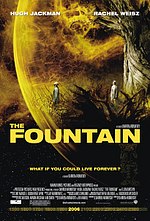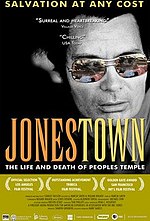
Knight at the Movies Archives
Hugh Jackman, this year's Jude Law, in yet another movie and a fascinating, unsettling documentary on the 1978 tragedy
Hugh Jackman has been making up for all that time he was off the screen and shaking his bon bon on Broadway playing gay icon
Peter Allen in the musical “The Boy From Oz.” So far this year we’ve seen the studly Mr. Jackman in Scoop, X Men: The Last Stand and
The Prestige (his Aussie accented voice is also featured in both Flushed Away and Happy Feet). Now comes The Fountain in which
Jackman has the most satisfying role of the lot. The film, director Daren Aronofsky’s long awaited follow-up to the indie hit Requiem
for a Dream, gives Jackman one of the richest parts of his career. Whether audiences will appreciate it, however – or this sad, poetic
movie – remains to be seen.
The Fountain, beautifully shot in shades of gold and black, has three parallel stories that take place a thousand years apart. The
movie takes on big themes – love, death, spirituality, eternal life – but for me its emphasis on the metaphysical was at times too
earnest, maudlin and altogether too literal. However, its poignant and rather persuasive tone, strong performances from the leads,
and stunning visuals are going to make it one of those movies that people will go to the mat over.
Jackman throws himself into his three roles, Tomas, Tommy, and Tom Creo. In the first, he is a Spanish explorer trying to find the
fountain of youth at the behest of his beautiful queen Isabel. In the second, he is a scientist desperately trying to find a miracle
elixir to cure his cancer riddled but peaceful wife Izzi and in the third, he’s a bald headed man from either the future or another
plane of consciousness. In either case, he seems to live at the base of the tree of life inside a giant snow globe floating in space
that offers spectacular views of the nearby solar system. Rachel Weisz plays his three female counterparts and Ellyn Burstyn has a
small role as the empathetic doctor in charge of the experimental drug clinic where Jackman is looking for the cure for Weisz’s
cancer.
Both Jackman and Weisz give nuanced performances in what is, stripped to the basics, a gloomy weepie – a reverse version of Dying
Young – and on that level the movie delivers emotionally (so yes, bring along the tissues). And though the film (which Aronofsky
wrote as well as directed) focuses on a quest for eternal life it seems at times to instead be a love letter to eternal death – the same
creepy feeling one gets from listening to the Blue Oyster Cult classic “Don’t Fear the Reaper” hangs over the movie as surely as
those tree branches over Jackman.
The “forever and ever” stuff was okay by me but then, when the film moved into its last section as the music swelled and the snow
globe and Jackman started to ascend through the heavens (kinda like Grizabella on the tire in “Cats”), I thought, “Oh dear – well,
it's just too literal. Some things just can’t be shown, I guess.” But I can imagine circumstances in which this sort of stuff might work,
be inspirational even – if one had recently dropped acid or some other hallucinogenic, say, or were touring one of those hi tech art
museums and taking in one of the exhibits. That last sequence killed for me what up to then had been a pretty involving albeit
fancy schmancy tale of Doomed Romance along the lines of Love Story.
+++++++++++++++++++++++++++++++++++++++++++++++++++++++++++++++++++++++++++++++++++++++++++++
November 18th marked a terrible anniversary –the 28th – of the Guyana tragedy in which 909 members of the Peoples Temple and
their insane leader Jim Jones died in a mass suicide/murder over which Jones presided. The members of Jones’ cult had traveled to
Guyana from San Francisco just a year earlier, seeking a better way of life for their integrated (the congregation was 80% black),
Socialist based group.
The story of the rise of Jones and what happened in Guyana has been the stuff of countless books and an excellent TV movie with
Powers Booth riveting in the title role (and Veronica Cartwright also magnificent as Jones’ put upon wife). Now filmmaker Stanley
Nelson has assembled a riveting documentary that allows survivors and surviving family members to tell the story. Jonestown:
The Life and Death of Peoples Temple also utilizes new footage, audio recordings, and photographs that reveal fresh facets
to this tragic tale. These recall the early promise of the group and we see that on some levels the experiment was having success.
And Jones’ message of tolerance for all certainly had appeal not just to minorities but to gays and lesbians (the church boasted
dozens of queer members). One former Peoples Temple member comments at the outset, “Nobody joins a cult. You join things to
be with people you like.”
But within the early successes were the seeds of the church’s demise – Jones’ strange sexual predilections, his paranoia at anyone
trying to leave his flock, his insistence that he become a father figure to his parish members, and his abuses of power behind the
scenes are mulled over by survivors. Jones actively courted both women and men to satisfy his sexual urges and one survivor vividly
recalls a young man openly suggesting to the congregation that “Everybody who wants Father to screw them in the butt should take
an enema first” that was followed by a show of hands from those who had already been recipients of this special attention. Others
recall the tactics used to keep members in line and focused on their leader.
Finally, the film moves to Jonestown and the visit of Senator Ryan that led up to the tragic final events. Here Nelson utilizes
amazing footage taken of the group the night before the tragedy (musicians played Earth, Wind & Fire’s “That’s the Way of the
World” as people sang, danced and celebrated) and throughout the following day – almost up to the moment of the mass
suicide/murder. But Nelson doesn’t editorialize or present any of the material in a sensational manner, allowing it to speak for
itself. This excellent documentary is getting its Chicago premiere from November 24-30 at the Gene Siskel Center. Highly
recommended. www.siskelfilmcenter.com
Peter Allen in the musical “The Boy From Oz.” So far this year we’ve seen the studly Mr. Jackman in Scoop, X Men: The Last Stand and
The Prestige (his Aussie accented voice is also featured in both Flushed Away and Happy Feet). Now comes The Fountain in which
Jackman has the most satisfying role of the lot. The film, director Daren Aronofsky’s long awaited follow-up to the indie hit Requiem
for a Dream, gives Jackman one of the richest parts of his career. Whether audiences will appreciate it, however – or this sad, poetic
movie – remains to be seen.
The Fountain, beautifully shot in shades of gold and black, has three parallel stories that take place a thousand years apart. The
movie takes on big themes – love, death, spirituality, eternal life – but for me its emphasis on the metaphysical was at times too
earnest, maudlin and altogether too literal. However, its poignant and rather persuasive tone, strong performances from the leads,
and stunning visuals are going to make it one of those movies that people will go to the mat over.
Jackman throws himself into his three roles, Tomas, Tommy, and Tom Creo. In the first, he is a Spanish explorer trying to find the
fountain of youth at the behest of his beautiful queen Isabel. In the second, he is a scientist desperately trying to find a miracle
elixir to cure his cancer riddled but peaceful wife Izzi and in the third, he’s a bald headed man from either the future or another
plane of consciousness. In either case, he seems to live at the base of the tree of life inside a giant snow globe floating in space
that offers spectacular views of the nearby solar system. Rachel Weisz plays his three female counterparts and Ellyn Burstyn has a
small role as the empathetic doctor in charge of the experimental drug clinic where Jackman is looking for the cure for Weisz’s
cancer.
Both Jackman and Weisz give nuanced performances in what is, stripped to the basics, a gloomy weepie – a reverse version of Dying
Young – and on that level the movie delivers emotionally (so yes, bring along the tissues). And though the film (which Aronofsky
wrote as well as directed) focuses on a quest for eternal life it seems at times to instead be a love letter to eternal death – the same
creepy feeling one gets from listening to the Blue Oyster Cult classic “Don’t Fear the Reaper” hangs over the movie as surely as
those tree branches over Jackman.
The “forever and ever” stuff was okay by me but then, when the film moved into its last section as the music swelled and the snow
globe and Jackman started to ascend through the heavens (kinda like Grizabella on the tire in “Cats”), I thought, “Oh dear – well,
it's just too literal. Some things just can’t be shown, I guess.” But I can imagine circumstances in which this sort of stuff might work,
be inspirational even – if one had recently dropped acid or some other hallucinogenic, say, or were touring one of those hi tech art
museums and taking in one of the exhibits. That last sequence killed for me what up to then had been a pretty involving albeit
fancy schmancy tale of Doomed Romance along the lines of Love Story.
+++++++++++++++++++++++++++++++++++++++++++++++++++++++++++++++++++++++++++++++++++++++++++++
November 18th marked a terrible anniversary –the 28th – of the Guyana tragedy in which 909 members of the Peoples Temple and
their insane leader Jim Jones died in a mass suicide/murder over which Jones presided. The members of Jones’ cult had traveled to
Guyana from San Francisco just a year earlier, seeking a better way of life for their integrated (the congregation was 80% black),
Socialist based group.
The story of the rise of Jones and what happened in Guyana has been the stuff of countless books and an excellent TV movie with
Powers Booth riveting in the title role (and Veronica Cartwright also magnificent as Jones’ put upon wife). Now filmmaker Stanley
Nelson has assembled a riveting documentary that allows survivors and surviving family members to tell the story. Jonestown:
The Life and Death of Peoples Temple also utilizes new footage, audio recordings, and photographs that reveal fresh facets
to this tragic tale. These recall the early promise of the group and we see that on some levels the experiment was having success.
And Jones’ message of tolerance for all certainly had appeal not just to minorities but to gays and lesbians (the church boasted
dozens of queer members). One former Peoples Temple member comments at the outset, “Nobody joins a cult. You join things to
be with people you like.”
But within the early successes were the seeds of the church’s demise – Jones’ strange sexual predilections, his paranoia at anyone
trying to leave his flock, his insistence that he become a father figure to his parish members, and his abuses of power behind the
scenes are mulled over by survivors. Jones actively courted both women and men to satisfy his sexual urges and one survivor vividly
recalls a young man openly suggesting to the congregation that “Everybody who wants Father to screw them in the butt should take
an enema first” that was followed by a show of hands from those who had already been recipients of this special attention. Others
recall the tactics used to keep members in line and focused on their leader.
Finally, the film moves to Jonestown and the visit of Senator Ryan that led up to the tragic final events. Here Nelson utilizes
amazing footage taken of the group the night before the tragedy (musicians played Earth, Wind & Fire’s “That’s the Way of the
World” as people sang, danced and celebrated) and throughout the following day – almost up to the moment of the mass
suicide/murder. But Nelson doesn’t editorialize or present any of the material in a sensational manner, allowing it to speak for
itself. This excellent documentary is getting its Chicago premiere from November 24-30 at the Gene Siskel Center. Highly
recommended. www.siskelfilmcenter.com
Deep and Dark:
The Fountain-Jonestown: The Life and Death of Peoples Temple
11-22-06 Windy City Times Knight at the Movies Column
By Richard Knight, Jr.
The Fountain-Jonestown: The Life and Death of Peoples Temple
11-22-06 Windy City Times Knight at the Movies Column
By Richard Knight, Jr.


